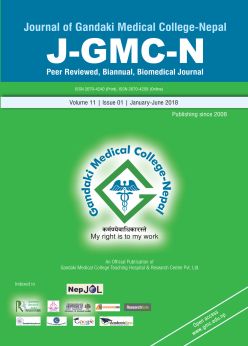Use of Trochanteric Flip Osteotomy Improves the Outcome of Pipkin I and II Femoral Head Fractures
DOI:
https://doi.org/10.3126/jgmcn.v11i02.22959Keywords:
Femoral head fracture, Medial femoral circumflex artery, Pipkin I and II, Trochanteric flip osteotomyAbstract
Introduction: Annual incidence of femoral head fracture is constantly increasing due to increase in cases of road traffic accidents (RTA). Four to 17% of femoral head fractures are due to posterior dislocations of hip. Outcome of femoral head facture associated with posterior dislocation of hip, the pipkin I and II fracture, is unsatisfactory due to lack of universally accepted protocol for its management and treatment.
Objective: To evaluate the patient outcome using relatively newer approach, the Trochanteric Flip (digastrics) Osteotomy (TFO), for the precise anatomical reduction of femoral head fractures associated with posterior dislocation of hip.
Methods: Between 2013 and 2017, 21 patients with sustained isolated femoral head fracture were admitted at our hospital. We used TFO approach for the management and treatment of femoral head fractures. The patients were followed up for 42 months at different intervals. Clinical outcome were evaluated using Merle d’Aubigne Postel and Thompson-Epstein scale.
Results: Retrospective analysis showed excellent, good, fair and poor results in five (23.8%) patients, 13 (61.9%) patients, two (9.5%) patients and one (4.7%) patient, respectively. Clinical outcomes included sciatic nerve injury (4.7%), moderate arthritis (95.3%), benign non-debilitating heterotrophic ossification (19%), avascular necrosis of femoral head (4.7%) and neuropraxia (4.7%).
Conclusions: Use of trochanteric flip osteotomy gives the favorable outcome for the treatment of this type of fracture. Most importantly, the vascularity of femoral head remains intact which makes TFO a very useful technique for pipkin I and II fracture treatment.
Downloads
Downloads
Published
How to Cite
Issue
Section
License
This license allows reusers to distribute, remix, adapt, and build upon the material in any medium or format for noncommercial purposes only, and only so long as attribution is given to the creator.

